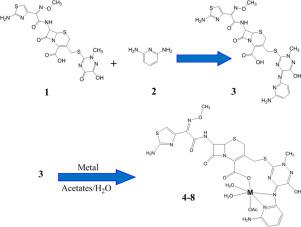Journal of Inorganic Biochemistry ( IF 3.8 ) Pub Date : 2021-06-17 , DOI: 10.1016/j.jinorgbio.2021.111519 J R Anacona 1 , Javier Santaella 1 , Rehab Kadhim Raheem Al-Shemary 2 , José Amenta 1 , Adriana Otero 1 , Cesar Ramos 1 , Freddy Celis 3

|
From the reaction of ceftriaxone 1 antibiotic with 2,6-diaminopyridine 2 a ceftriaxone-based Schiff base (H2L,3) was obtained and its transition metal complexes were synthesized. Spectroscopic and physicochemical techniques, namely, UV–visible, FT-IR, 1H NMR, EPR, mass spectrometry, molar conductance, magnetic susceptibility and density functional theory (DFT) calculations, together with elemental and thermal analyses, were used to find out the binding mode and composition of these complexes. The ceftriaxone-based Schiff base 3 behaves as a monoanionic tridentate N,N,O ligand. Spectral and magnetic data suggest an octahedral geometry for all complexes and the general formulae [M(HL)(OAc)(H2O)2] (M(II) = Mn2+ 4, Co2+ 5, Ni2+ 6, Cu2+ 7, Zn2+ 8), are proposed for them. All compounds were screened for antibacterial activity using both the agar disc diffusion method and the minimal inhibitory concentration (MIC). It was found that complex 8 exhibited the most promising bactericidal activity against S. aureus (MIC = 0.0048 μmol/ml) and E. coli (MIC = 0.0024 μmol/ml). It is more active than the free ligand 1 (MIC = 0.0560 μmol/ml for S. aureus and 0.0140 μmol/ml for E. coli). These MIC results were compared with those obtained using similar zinc(II) Schiff base complexes, and with the values obtained using ceftriaxone conjugated with silver and gold nanoparticles (NPs), using earlier published data. Synthesized metal complexes exhibited LC50 values >1000 ppm indicating their nontoxicity against brine shrimp nauplii (Artemia Salina).
中文翻译:

基于头孢曲松的席夫碱过渡金属 (II) 配合物。合成、表征、细菌毒性和 DFT 计算。一种新型 Zn(II) 复合物对金黄色葡萄球菌和大肠杆菌的抗菌活性增强
由头孢曲松1抗生素与2,6-二氨基吡啶2反应得到头孢曲松基席夫碱(H 2 L, 3 )并合成其过渡金属配合物。光谱和物理化学技术,即紫外-可见、FT-IR、1 H NMR、EPR、质谱、摩尔电导、磁化率和密度泛函理论 (DFT) 计算,以及元素和热分析,用于找出这些配合物的结合方式和组成。基于头孢曲松的席夫碱3表现为单阴离子三齿 N,N,O 配体。光谱和磁性数据表明所有配合物的八面体几何结构和通式 [M(HL)(OAc)(H 2 O) 2 ] (M(II) = Mn 2+ 4 , Co 2+ 5 , Ni 2+ 6 , Cu 2+ 7 , Zn 2+ 8 ), 为他们提出。使用琼脂盘扩散法和最小抑制浓度 (MIC) 筛选所有化合物的抗菌活性。发现复合物8对金黄色葡萄球菌(MIC = 0.0048 μmol/ml)和大肠杆菌表现出最有希望的杀菌活性(MIC = 0.0024 μmol/ml)。它比游离配体1更具活性(金黄色葡萄球菌的 MIC = 0.0560 μmol/ml ,大肠杆菌的 0.0140 μmol/ml )。将这些 MIC 结果与使用类似的锌 (II) 席夫碱复合物获得的结果进行比较,并使用早期公布的数据与使用头孢曲松与银和金纳米粒子 (NPs) 结合获得的值进行比较。合成的金属配合物表现出 LC 50值 >1000 ppm,表明它们对盐水虾无节幼体 ( Artemia Salina ) 无毒。











































 京公网安备 11010802027423号
京公网安备 11010802027423号